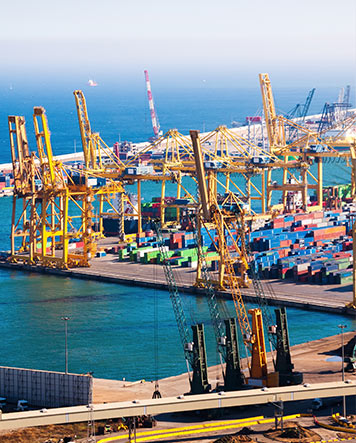PLCs and DCSs in Ports: Automating Material Handling and Logistics for Global Trade
Introduction
Modern ports are complex, dynamic hubs of global trade, handling vast quantities of cargo, diverse vessel types, and intricate logistics operations. Efficiency, safety, and reliability are paramount for maintaining smooth cargo flow and minimizing turnaround times. Programmable Logic Controllers (PLCs) and Distributed Control Systems (DCSs) are essential automation technologies that play critical roles in optimizing operations across various port facilities, from container terminals to bulk cargo handling.
PLC Applications in Port Operations
PLCs are widely used for discrete control, managing individual machines, and handling specific tasks within port environments:
- Ship-to-Shore (STS) Cranes: PLCs control the hoisting, trolleying, and gantry movements of STS cranes, which load and unload containers from ships. This includes:
- Motor Control: Precise control of motors for smooth and accurate crane movements.
- Anti-Sway Control: Implementing anti-sway systems to minimize container swing.
- Safety Interlocks: Ensuring safe crane operation and preventing collisions.
- Load Monitoring: Monitoring container weight and preventing overloads.
- Rubber-Tired Gantry (RTG) Cranes: PLCs control RTG cranes, which stack and move containers within the container yard.
- Rail-Mounted Gantry (RMG) Cranes: PLCs control RMG cranes, which are used for stacking containers and transferring them to and from trains.
- Automated Stacking Cranes (ASCs): PLCs are the core control system for ASCs, which operate autonomously within the container yard.
- Conveyor Systems: PLCs control conveyor systems used for transporting bulk cargo, such as coal, grain, and ore.
- Gate Systems: PLCs control automated gate systems, which manage the entry and exit of trucks and other vehicles.
- Reefer Container Monitoring: PLCs monitor and control the temperature and humidity of refrigerated containers (reefers).
- Yard Management Systems (Partially): PLCs provide the real-time control and data acquisition for yard management, although higher-level systems often manage overall yard strategy.
- Safety Systems: PLCs are used in safety systems to monitor crane operations, prevent collisions, and ensure the safety of personnel.
DCS Applications in Port Operations
DCSs are employed for continuous process control, plant-wide integration, and overall system management in larger port facilities, particularly those handling bulk materials or liquids:
- Bulk Material Handling Terminals: DCSs control the entire bulk material handling process, from unloading ships to storing and loading cargo onto trains or trucks. This includes:
- Stacker/Reclaimer Control: Managing the operation of stackers and reclaimers.
- Conveyor System Control: Coordinating the operation of multiple conveyor systems.
- Silo and Hopper Control: Managing the filling and emptying of silos and hoppers.
- Dust Suppression Systems: Controlling dust suppression systems to minimize environmental impact.
- Liquid Bulk Terminals: DCSs control the handling of liquid bulk cargo, such as oil, chemicals, and liquefied natural gas (LNG). This includes:
- Pump and Valve Control: Managing the flow of liquids through pipelines and storage tanks.
- Tank Level Monitoring: Monitoring the level of liquids in storage tanks.
- Leak Detection Systems: Implementing leak detection systems to prevent spills.
- Safety Shutdown Systems: Implementing safety shutdown systems to prevent accidents.
- Terminal Operating Systems (TOS) (Integration): DCSs integrate with the TOS, providing real-time data on equipment status, cargo location, and process parameters.
- Energy Management: DCSs optimize energy consumption throughout the port, including lighting, HVAC, and equipment operation.
- Environmental Monitoring: DCSs monitor air and water quality, ensuring compliance with environmental regulations.
- Remote Monitoring and Control: DCSs enable remote monitoring and control of port operations, allowing operators to manage the facility from a central control room.
Hybrid Systems and Integration (PLCs and DCSs)
Many modern ports utilize hybrid systems, combining the strengths of PLCs and DCSs:
- PLC for Local Control: PLCs handle the fast, discrete control of individual machines, such as cranes and conveyors.
- DCS for Overall Coordination: The DCS oversees the entire port operation, manages bulk material handling processes, and provides a unified platform for monitoring and control.
- Data Exchange and Communication: PLCs and DCSs communicate with each other, exchanging data and coordinating operations. This is crucial for seamless operation and optimization.
- TOS/ERP Integration: Both PLCs and DCSs are often integrated with Terminal Operating Systems (TOS) and Enterprise Resource Planning (ERP) systems. This provides real-time data for planning, scheduling, billing, and inventory management.
Benefits of PLCs and DCSs in Port Operations
- Increased Efficiency: Automation reduces turnaround times for ships and trucks, increases throughput, and optimizes resource utilization.
- Improved Safety: Automation reduces the risk of human error and improves workplace safety.
- Reduced Operating Costs: Automation reduces labor costs, energy consumption, and maintenance expenses.
- Enhanced Security: Automated gate systems and surveillance systems improve security and prevent unauthorized access.
- Real-Time Visibility: DCSs provide real-time visibility of port operations, allowing operators to make informed decisions and respond quickly to changing conditions.
- Data-Driven Optimization: Data from PLCs and DCSs provides valuable insights for process optimization, predictive maintenance, and continuous improvement.
- Scalability and Flexibility: PLC and DCS systems can be easily scaled and adapted to accommodate changes in cargo volume, vessel types, and operational requirements.
Conclusion
PLCs and DCSs are essential technologies for modern port operations. They provide the automation, control, and integration capabilities needed to manage complex logistics, ensure safety, improve efficiency, and meet the demands of global trade. The trend towards hybrid systems, remote operation, automated terminals, and greater integration with TOS/ERP will continue to drive innovation and optimization in the port industry, ensuring the smooth and efficient flow of goods around the world. The reliability and robustness of these systems are crucial for maintaining 24/7 operations in often challenging environmental conditions.
 中文版
中文版






